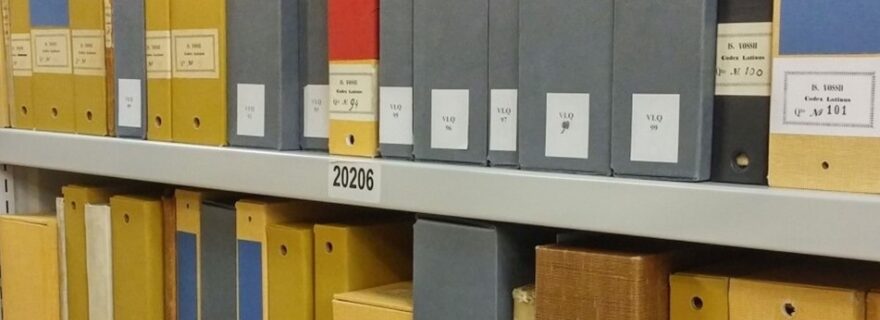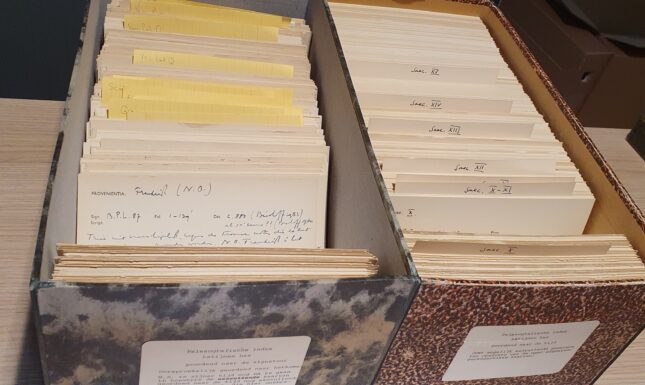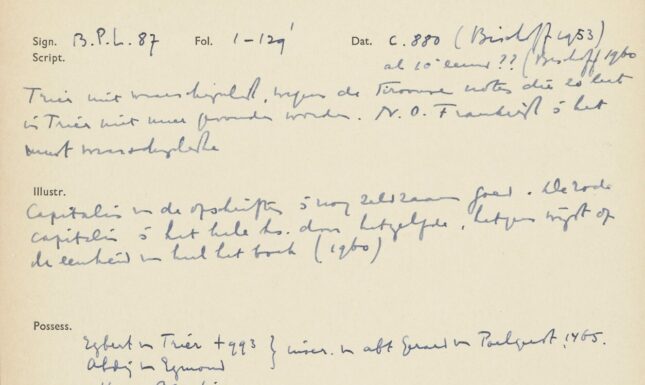Medieval Manuscripts Catalogued in Leiden: Old and New Practices
Since its establishment, Leiden University Libraries has assembled 1400+ codices from medieval Europe and some thousand manuscript fragments. Their presentation in catalogues and inventories has changed radically over time.
Beginnings
The library of Leiden University was founded in 1587; early on it collected not only printed books but also western medieval manuscripts. Some of them already occur in the first printed library catalogue, compiled by Petrus Bertius. His Nomenclator autorum omnium, quorum libri vel manuscripti, vel typis expressi exstant in Bibliotheca Academiae Lugduno-Batavae (1595) was the first complete printed catalogue of any institutional library in the world. It was published twenty years after the University’s foundation and accompanied the reinstallment of the book collection in the upper floor of the Beguinage Chapel (located near the Rapenburg and reused as an academy building). The books were arranged by field of study: the largest chained in plutei – open bookcases with integral reading desks – the smaller formats placed in two closed bookcases, as can be seen in the print of the library by Woudanus, published in 1610.
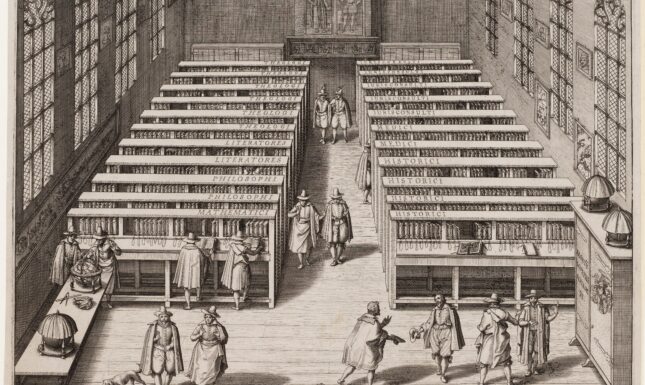

One of these early accessions is a Carolingian manuscript containing Martianus Capella’s De nuptiis Philologiae et Mercurii, a Latin compendium of late-antique knowledge drawing on the seven liberal arts that were also essential to medieval education (BPL 87). The old codex (dating from the second half of the ninth century, or early tenth) with its extensive glossing, was donated by a Leiden professor of rhetoric, Henricus Bredius. It must have been valued as a treasure, well suited for the library of a humanist academy. The Nomenclator, arranged as a shelf list, mentions rather than describes the codex as one of the chained volumes in the ‘Litteratores’ book case: “Martianus Capella MS. No 28.” (p. K1v). No further detail concerning its material form or content is provided.
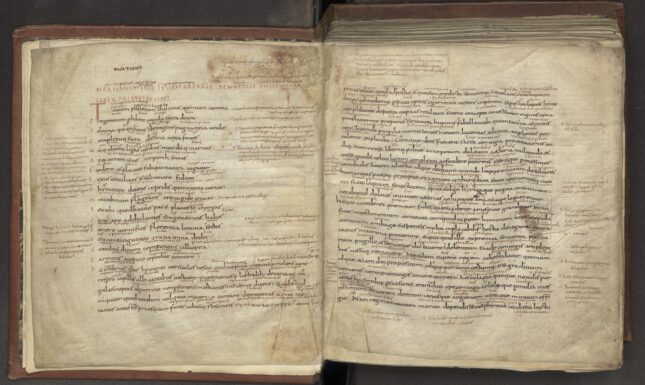

During the centuries that followed, numerous purchases, donations, bequests and long-term loans resulted in a steady growth of the Library holdings, sometimes by entire collections, for which the network of Leiden professors proved to be essential. Substantial parts of the private libraries of Scaliger (bequeathed 1609), Vulcanius (purchased 1614), Vossius (purchased 1690), Perizonius (bequeathed 1715) and others were incorporated in the Library’s holdings. Their printed books were filtered out and placed next to the other printed volumes, arranged by field of study (until the 1860s, when a more efficient manner of storage, by format, was adopted). The medieval and post-medieval manuscripts (mostly scholarly notes and correspondence) in these collections were then placed apart and named after their last owner: Codices Scaligerani, Vulcaniani, Vossiani, Perizoniani, receiving their own set of shelfmarks. The number of medieval codices at the Library amounts to some 1400 codices to date. Moreover, nearly a thousand manuscript fragments were discovered during the nineteenth and twentieth centuries in the process of replacing or restoring the bindings of damaged books. From the 1940s onwards, these fragments were gradually registered and included in the Bibliotheca Publica Latina collection.
Printed catalogues
To keep track of the constant influx of accessions, the Library staff had to note them down in an interleaved copy of the printed catalogue. But users outside the Library could only learn about the latest acquisitions when a new, augmented catalogue was printed — which was done in 1612, 1623, 1640, 1674 and 1716, with a supplement in 1741. The Catalogus librorum tam impressorum quam manuscriptorum Bibliothecae Publicae Universitatis Lugduno-Batavae (1716) was the last Leiden catalogue listing all Library holdings. Nearly 700 medieval manuscripts are listed on pages 324-333 (BPL), 334-338 (BPG), 339-343 (Scaliger), 339-343 (Vulcanius), 358-403 (Vossius) and 493-494 Perizonius).
Jacob Geel was the first Leiden librarian to compile a catalogue focusing exclusively on western manuscripts. His Catalogus librorum manuscriptorum qui inde ab anno 1741 Bibliothecae Lugduno Batavae accesserunt (1852) covered all accessions of both medieval and post-medieval manuscripts since 1741, with 244 of its 1015 entries describing medieval manuscripts. Since then, Leiden colleagues following in Geel’s footsteps have published seventeen catalogues or inventories featuring medieval manuscripts. Most of these publications are in Latin, but some are also in Dutch, French and English. Their descriptions have clearly profited from the progress made in the fields of philology, palaeography and book history.
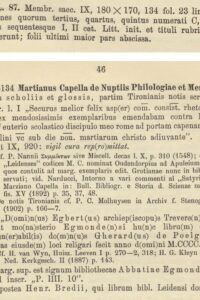

Take for instance the brief description of the Martianus Capella codex (BPL 87) in the 1716 catalogue: ‘Martiani Minei Felicis Capellae libri VII (ibi enim finit) de nuptiis Philologiae, cum adscriptis hic glossis. Membran. vetustissima. 87’. Two centuries later, Philipp Molhuysen has a lot more to say in his Codices Bibliothecae Publicae Latini (1912), still in Latin, but focusing on material aspects, such as size and quire structure, as well as providing useful information concerning its provenance (the monastery of Egmond in the Netherlands), and recounting how it entered the library (through Bredius).
In 2009, almost a century later, Leiden’s late Professor of Western Palaeography Peter Gumbert described all medieval codices and fragments of the Bibliotheca Publica Latina collection (including the accessions since 1912) in his Illustrated Inventory of Medieval Manuscripts, vol. 2: BPL (2009). It was a new type of inventory, designed to record data from large numbers of medieval manuscripts and fragments in a uniform manner, focusing on the text carriers instead of the texts.
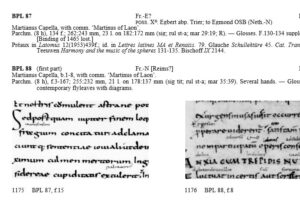

Each numbered entry (for composite manuscripts: a series of entries), provides a condensed description of material aspects, a small reproduction of a script specimen, notes on medieval agents (scribes, owners etc.) and important publications. In comparison with the Molhuysen catalogue, Gumbert’s entries contain more accurate information (for instance on creation date and place of the manuscripts), reflecting not only his own expertise but also the huge progress made in the fields of palaeography and codicology since the 1950s. So far, Gumbert’s ‘IIMM’ volume of 2009 is the last Leiden catalogue of western medieval manuscripts that appeared in print.
Card Catalogues
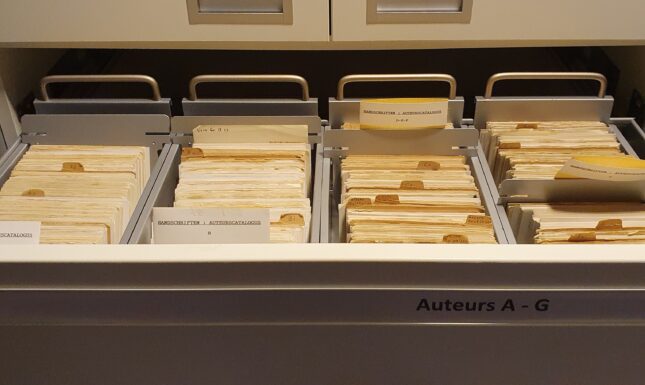
It was only in the nineteenth century that the Library started to use more flexible card catalogues for its local users and also for its own collection management: each title description was written (or later printed) on multiple cards and included in the alphabetic, systematic and shelf list catalogues. These general card catalogues, however, did not include the western manuscripts collection. Willem Nicolaas du Rieu, Leiden's first curator of western manuscripts (appointed in 1866), and his successors compiled a separate card catalogue for the users of the ‘Handschriftenkamer’, indexing author and titles, former owners, scribes and binders alphabetically, anonymous works systematically, and secondary literature by shelfmark – of course heavily drawing on the printed catalogues.
After World War II curator Isaac Lieftinck started triple-card indexes for two categories of medieval manuscripts – those in Latin and in Greek – sorted by origin, by century and by shelfmark, as seen in the first image below of the paleographical index of medieval codices in Latin (arranged by shelfmark in the box on the right, by century on the left). These card indexes contain many codicological and palaeographical observations that are not available in the printed catalogues (as is visible in the second image, which contains Lieftinck's paleographical notes on BPL 87).
Digital Catalogues
The Library had already begun automating its workflows when I joined the Department of Western Manuscripts, in September 1990. Soon, important steps were taken into the ‘Digital Age’ — thanks to the internet, email, the introduction of online catalogues and authority files. A further giant leap (if not for mankind, then certainly for university staff and students) involved the digitisation of the information itself: today users increasingly consult e-books, e-journals, but also digital versions of special collections objects.
A first set of short-title catalogue records for the western manuscripts was created in 2004-2005 and published together with digital images of specimen pages in a separate special collections database, DigiTool. In the 2010s its metadata were migrated to the general online catalogue, and a new image repository emerged, Digital Collections. During the last decade the Library has not only digitized over a thousand medieval codices but also all relevant printed catalogues concerning the material (from 1595 onwards). All digitised materials have been published with persistent identifiers: image links that remain valid after software updates or data migration to a new system. The Library also joined the International Image Interoperability Framework in 2020. All Leiden images are IIIF-compliant, enabling online use outside the local repository in platforms and databases of third parties, such as Biblissima, Europeana and eCodices-nl.
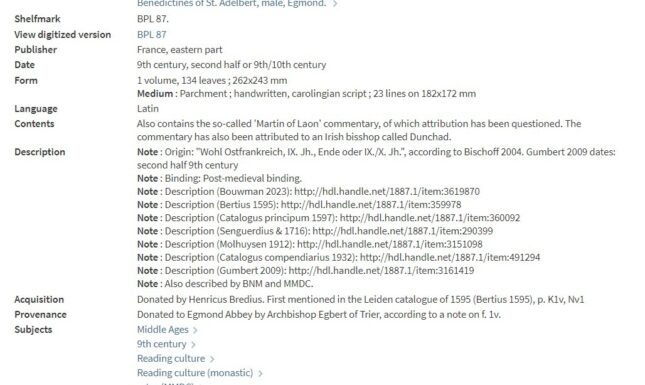

During the summer of 2023, new bibliographic records in English were created for all western medieval manuscripts. Significantly, the new subject guide Medieval Manuscripts offers various perspectives on the collection items (classifying them by origin, century, language, text genre etc.), with deep links to the online catalogue provided. Take a look at the new catalogue record for BPL 87 above. It offers codicological, textual and book-historical information, but also references to recent publications and persistent identifiers to the digital version of the codex and of several printed library catalogues describing this codex. It also includes a link to my Inventory of Western Medieval Manuscripts Held by Leiden University Libraries, published as a pdf last October.
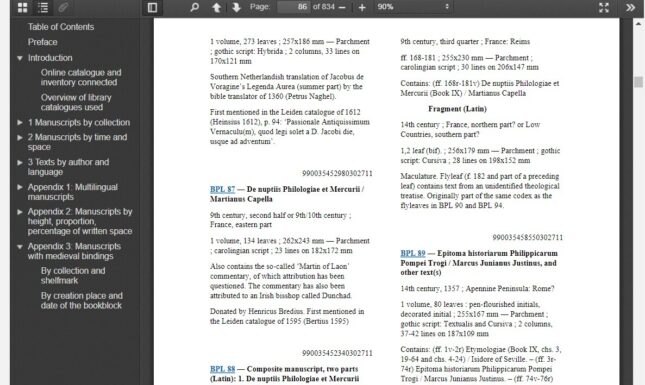

Why do we need an inventory when all items have already been described in Leiden’s online catalogue? Because here, for the first time, all of Leiden’s medieval manuscripts are described in one document, in the same format. Because searching some 1800 manuscript records in an online catalogue with millions of bibliographic descriptions is far from easy: browsing and reading a results list (after a search) is time-consuming; you have to switch back and forth between different levels of information; you have to look into so-called ‘multiple versions’ and read pages cluttered with detail. An interconnective pdf inventory offers clear advantages. It contains a concise presentation of all medieval manuscripts, clearly arranged by collection and shelfmark. It provides various indexes, a clickable navigation menu, a standard search function for word strings, and for each manuscript the user can link through to the corresponding catalogue record. Further, users of the online catalogue can, in their turn, navigate to the wider context of my inventory, thanks to a link present in each manuscript record.
I believe that this ‘two-way street’ type of connection between the catalogue and inventory will improve the online access to Leiden’s medieval manuscripts considerably. I am interested to learn whether in practice users are of the same view.
© André Bouwman and Leiden Medievalists Blog, 2023. Unauthorised use and/or duplication of this material without express and written permission from this site’s author and/or owner is strictly prohibited. Excerpts and links may be used, provided that full and clear credit is given to André Bouwman and Leiden Medievalists Blog with appropriate and specific direction to the original content.


